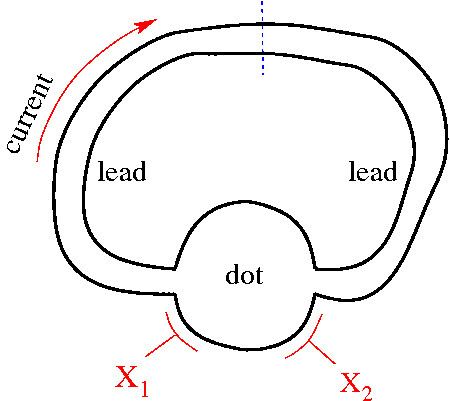 | ||
A pump is an alternating current-driven device that generates a direct current (DC). In the simplest configuration a pump has two leads connected to two reservoirs. In such open geometry the pump takes particles from one reservoir and emits them into the other. Accordingly, a current is produced even if the reservoirs have the same temperature and chemical potential.
Contents
- Main observations
- The Kubo approach to quantum stirring
- The scattering approach to quantum pumping
- The effect of interactions
- References
Stirring is the operation of inducing a circulating current with a non-vanishing DC component in a closed system. The simplest geometry is obtained by integrating a pump in a closed circuit. More generally one can consider any type of stirring mechanism such as moving a spoon in a cup of coffee.
Main observations
Pumping and stirring effects in quantum physics have counterparts in purely classical stochastic and dissipative processes. The studies of quantum pumping and of quantum stirring emphasize the role of quantum interference in the analysis of the induced current. A major objective is to calculate the amount
Electric stirring explicitly breaks time-reversal symmetry. This property can be used to induce spin polarization in conventional semiconductors by purely electric means. Strictly speaking stirring is a non-linear effect, because in linear response theory (LRT) an AC driving induces an AC current with the same frequency. Still an adaptation of the LRT Kubo formalism allows the analysis of stirring. The quantum pumping problem (where we have an open geometry) can be regarded as a special limit of the quantum stirring problem (where we have a closed geometry). Optionally the latter can be analyzed within the framework of scattering theory. Pumping and Stirring devices are close relatives of ratchet systems. The latter are defined in this context as AC driven spatially periodic arrays, where DC current is induced.
It is possible to induce a DC current by applying a bias, or if the particles are charged then by applying an electro-motive-force. In contrast to that a quantum pumping mechanism produces a DC current in response to a cyclic deformation of the confining potential. In order to have a DC current from an AC driving, time reversal symmetry (TRS) should be broken. In the absence of magnetic field and dissipation it is the driving itself that can break TRS. Accordingly, an adiabatic pump operation is based on varying more than one parameter, while for non-adiabatic pumps modulation of a single parameter may suffice for DC current generation. The best known example is the peristaltic mechanism that combines a cyclic squeezing operation with on/off switching of entrance/exit valves.
The Kubo approach to quantum stirring
Consider a closed system which is described by a Hamiltonian
The conductance can be calculated and analyzed using the Kubo formula approach to quantum pumping, which is based on the theory of adiabatic processes. Here we write the expression that applies in the case of low frequency "quasi static" driving process (the popular terms "DC driving" and "adiabatic driving" turn out to be misleading so we do not use them):
where
where we define the normal vector
This formula can be regarded as the quantum adiabatic limit of the Kubo formula. The eigenstates of the system are labeled by the index
Accordingly, one can argue that the "magnetic charge" that generates (so to say) the
The scattering approach to quantum pumping
The Ohmic conductance of a mesoscopic device that is connected by leads to reservoirs is given by the Landauer formula: in dimensionless units the Ohmic conductance of an open channel equals its transmission. The extension of this scattering point of view in the context of quantum pumping leads to the Brouwer-Buttiker-Pretre-Thomas (BPT) formula which relates the geometric conductance to the
Here
The effect of interactions
A very recent work considers the role of interactions in the stirring of Bose condensed particles. Otherwise the rest of the literature concerns primarily electronic devices. Typically the pump is modeled as a quantum dot. The effect of electron–electron interactions within the dot region is taken into account in the Coulomb blockade regime or in the Kondo regime. In the former case charge transport is quantized even in the case of small backscattering. Deviation from the exact quantized value is related to dissipation. In the Kondo regime, as the temperature is lowered, the pumping effect is modified. There are also works that consider interactions over the whole system (including the leads) using the Luttinger liquid model.
